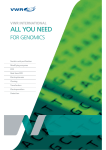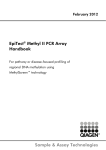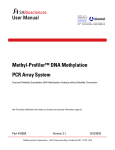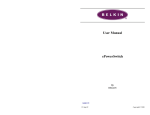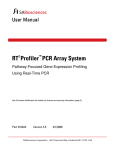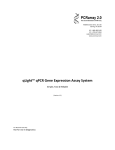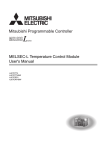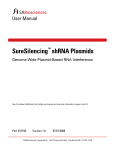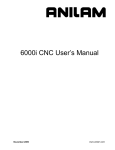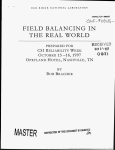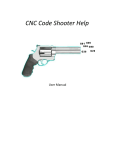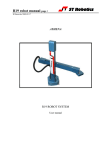Download User Manual - PCR Array 2.0 , Inc.
Transcript
46400 Benedict Drive, Ste 105 Sterling, VA 20164 (P): 1-866-489-5499 (F): 1-703-637-9863 [email protected] www.pcrarray2.com qMethyl™ DNA Methylation Detection qPCR System Simple, Fast, Reliable, No Bisulfite Conversion (Version 1.2) For Research Use Only Not For Use in Diagnostics User’s Manual - qMethyl™ DNA Methylation Detection qPCR System 1 Receiving, Unpacking and Storing the Products We recommend that you inspect the package of the products immediately after opening the shipping container and make sure that there are no visible damages to the product. Please contact PCRarray 2.0, Inc. for assistance if there are observable irregularities. Store the products according to the label on the package. Typically, we recommend that you store qMethylTM product at -20 °C for storage up to a 12 month period. Do not open the product container prior use. Water moisture may come in contact with the product and cause adverse effects on the performance. NOTE: We recommend that you immediately inspect the packages for possible visible damages due to shipment, and store the packages under conditions according to the product label. 2 User’s Manual - qMethyl™ DNA Methylation Detection qPCR System 2 Table of Contents 1. Receiving, Unpacking and Storing the Products........................................................................ 2 2. Table of Contents ...................................................................................................................... 3 3. General Information.................................................................................................................. 4 4. Warnings and Safety Precautions ............................................................................................ 5 5. Introduction .............................................................................................................................. 6 6. Materials Provided ................................................................................................................... 8 7. Additional materials & equipment required ............................................................................. 9 8. Consideration before Starting the Experiment ....................................................................... 11 9. Protocol 1: 96-well plate PCR array X1 for 1 sample, 44 gene assay ...................................... 13 10. Protocol 2: 384-well plate PCR array X1 for 4 samples, 44 gene assay................................... 16 11. Protocol 3: 96-well plate PCR array X 2 for 1 sample, 88 gene assay .................................... 19 12. Protocol 4: 384-well plate PCR array X1 for 2 samples, 92 gene assay................................... 22 11. Protocol 3: 96-well plate PCR array X 2 for 1 sample, 88 gene assay .................................... 19 12. Protocol 4: 384-well plate PCR array X1 for 2 samples, 92 gene assay................................... 22 13. Protocol 5: 384-well plate PCR array X1 for 1 sample, 188 gene assay .................................. 25 14. Protocol 6: Multiple sample assay of individual genes with a 96-well or 384-well plate ....... 28 15. Data analysis using ΔCt Methods ............................................................................................ 32 16. FAQs and Troubleshooting ...................................................................................................... 35 3 User’s Manual - qMethyl™ DNA Methylation Detection qPCR System 3 General Information qMethylTM products are covered by a limited warranty. A copy of the warranty is included with this manual (Appendix, to be added). The operator may be required to store received product under specified conditions as described herein to keep the warranty in effect. Information in this document is subject to change without notice. PCRarray 2.0, Inc. assumes no responsibility for any errors that may appear in this document. This document is believed to be complete and accurate at the time of publication. In no event shall PCRarray 2.0, Inc. be liable for incidental, special, multiple, or consequential damage in connection with or arising from the use of this product. qMethylTM product is designed for research use only and is not intended for use in diagnostic procedures. Use of the qMethylTM products conveys no patent rights, expressly or by implication, under any patent or patent application owned or licensed by PCRarray 2.0, Inc., that covers qMethylTM products. Specifically, but without limitation, no right, immunity, authorization, or license is granted, expressly or by implication, for the usage of qMethylTM technology. Limitation of Liability: Except to the extent prohibited by local law, in no event will PCRarray 2.0, Inc. be liable for the direct, indirect, or other damages arising out of the use, inability to use, or the results of using qMethylTM products. The use of these products is entirely at your own risk. 4 User’s Manual - qMethyl™ DNA Methylation Detection qPCR System 4 Warnings and Safety Precautions The following precautions should be followed to minimize the possibility of personal injury and/or damage to property while using qMethylTM products. All users should observe good laboratory practices (GLP). Examples of GLP include: a) Wearing of lab safety equipment, including gloves, eye protection and lab coat when preparing samples. b) Do not pipette by mouth; do not eat or drink in areas where specimens are being handled. c) Clean any spill immediately. d) Disposing of all specimens, controls and materials used in testing as though they contain infectious agents. 5 User’s Manual - qMethyl™ DNA Methylation Detection qPCR System 5 Introduction DNA methylation is the enzymatic addition of a methyl group to cytosines in CG dinucleotide DNA sequences (often at CpG-islands, CGI’s) without changing primary DNA sequences. Such modifications at gene regulatory regions, in particular promoters, correlate well with the transcriptional state of the cognate gene: hypermethylation represses transcription, while demethylation of previous methylated region reactivates the transcription. It is a fast growing research field in molecular biology, particularly in cancer epigenetic research field. Our qMethyl gene methylation system is a SYBR green real time PCR based detection system after complete digestion of sample DNA with optimized methylation sensitive restriction enzyme-buffer system. The whole procedure is very simple, fast, and reliable with much less genomic DNA compared to all bisulfite conversion-based methods. A. The Benefits 1. Simple & fast: In two hours, with just 0.5 to 1 µg genomic DNA for one sample, up to 44 target genes can be detected in one run with 96-well PCR plate, or 188 genes with 384-well PCR plate. 2. Reliable assay design: All the assays are specifically designed based on established methylated genomic region for known genes; 3. Complete digestion: guaranteed complete digestion of sample DNA with the optimized bufferenzyme system; 4. Robust quantitative PCR performance: The PCR primers and cycling parameters are specifically designed for very high GC-rich content; all the PCR reactions are validated; 5. High sensitivity: 20 methylated DNA copies can be reliably detected in 5ng genomic DNA in one reaction; 6. Free, easy to use online Data analysis software: within one minute, all genes in one run can be analyzed with the exported raw Ct values. 6 User’s Manual - qMethyl™ DNA Methylation Detection qPCR System B. The Outline of Simple Three-step Assay Step 1: DNA Digestion 1) Mix DNA with the digestion buffer 2) Divide the mix equally into two tubes 3) Add the enzymes accordingly 4) Incubate at 37 ⁰C for 6 hours – overnight Enzyme O Enzyme S 37 ⁰C 4 hours-overnight 1 2 3 4 5 6 7 8 9 10 11 12 Step 2: Setup and run the PCR reaction 1) Mix the two digests with PCR master mix individually , and load to the PCR plate 2) Run the Real-time PCR reactions A MoE B Reaction C D E MsE F Reaction G H Step 3: Data analysis 1) Collect raw Ct data 2) Use analysis template to obtain Data analysis methylation data Figure: The simple three-step assay Step 1: Mock DNA digestion wit Enzyme O and PCR (MoE): In the digestions, enzyme blend that do not digest targeted genomic regions is added. The PCR reactions measure the initial input DNA of the target regions. Step 2: Methylation sensitive enzyme digestion of DNA with Enzyme S and PCR (MsE): In the digestion, methylation-sensitive restriction enzyme S is added, so the unmethylated DNA will be cleaved, while the methylated DNA remains intact. The PCR reactions that follow measure the methylated DNA. Step 3: Data analysis: The hypermethylated and unmethylated DNA fractions in a sample are easily obtained simply by cutting and pasting the raw Ct values into the proper cells of the FREE qMethyl DNA Methylation Data Analysis Excel Template (See the instructions in the excel for detail). It is developed based on ΔCt method with MoE reaction Ct values as initial DNA input signals and those from MsE reaction as hypermethylated signal. 7 User’s Manual - qMethyl™ DNA Methylation Detection qPCR System 6 Materials Provided qMethyl array plates are provided based on the following format: Format Real-Time Instruments Plate: A All ABI standard blocks (7000, 7300, 7500, 7700, 7900) Bio-Rad iCycler, MyiQ Bio-Rad (MJ Research) Chromo 4 StepOnePlus 96-well B ABI 7500 and 7900 FAST 96-well blocks 96-well C Stratagene Mx3005p, Mx3000p 96-well D Bio-Rad (MJ Research) Opticon and Opticon 2 Stratagene Mx4000 96-well E 96-well F Roche LightCycler 480, 96-well block ABI 7900 384-well block G Roche LightCycler 480, 384-well block 384-well 384-well NOTE: The format of a PCR array is indicated by the last digit of the catalog number. Be sure that you have the correct PCR array format for your instrument before starting the experiment. For example: If Cat No.: HMET010-12A is ordered, twelve qMethyl plates of format A will be shipped. Each PCR array shipment includes the arrays and either twelve (12) optical thin-wall 8-cap strips (Formats A & D) or one (1) optical adhesive film (Formats B, C, E, F & G) per array. 8 User’s Manual - qMethyl™ DNA Methylation Detection qPCR System 7 Additional Materials & Equipment Required A. DNA Isolation Kit See our Recommendations in the Protocol Section. B. qMethyl Restriction Enzyme Kit EM-03 MANDATORY for a Complete DNA digestion C. qLight SYBR Green qPCR Master Mixes MANDATORY for a Complete and Successful Experiment Note: Be sure to pick the correct one for the instrumentation in your laboratory. Master mix Type qLight/ROX SYBR green Master Mix (MR1) qLight / Fluorescein SYBR Green Master Mix (MF2) qLight SYBR Green Master Mix (MM3 No reference dye) Cat No Size MR1-02 2X 96-well plates/ 200 rxn (2X1.3mL) MR1-12 12X 96-well plates/ 200 rxn (12X1.3mL) MR1-24 24X 96-well plates/ 200 rxn (24X1.3mL) MF2-02 2X 96-well plates/ 200 rxn (2X1.3mL) MF2-12 12X 96-well plates/ 200 rxn (12X1.3mL) MF2-24 24X 96-well plates/ 200 rxn (24X1.3mL) MM3-02 2X 96-well plates/ 200 rxn (2X1.3mL) MM3-12 12X 96-well plates/ 200 rxn (12X1.3mL) MM3-24 24X 96-well plates/ 200 rxn (24X1.3mL) Real-Time PCR cyclers All ABI & Stratagene Instrumentation, Eppendorf Mastercycler® ep realplex Instruments with ROX filter set BioRad iCylcer®, MyiQ®, and iQ5 Instrumentation BioRad Opticon, Opticon 2 & Chromo 4, Roche LightCycler® 480 System, Eppendorf Mastercycler® ep realplex Instruments without ROX filter set 9 User’s Manual - qMethyl™ DNA Methylation Detection qPCR System 1). 44-Gene, 96-Well PCR Arrays (Format A, B, C, D, E) Use the pack sizes of master mix described in the above table. 2). 88-Gene, 96-Well PCR Arrays (Format A, B, C, D, E) Each a set of 2 array packs requires two (2) of the correct master mix for your instrument (1 X MR-02/MF-02/MM-02). 3). 44-Gene, 384-Well PCR Arrays (Format F, G) Each 384-well PCR Array 4-pack (Formats F, G) requires four (4) of the correct master mix for your instrument (2 X MR-02/MF-02/MM-02). 4). 92 gene, 384-well PCR arrays (Format F, G) The two (2), twelve (12), and twenty-four (24) pack sizes (Formats F & G) require a quantity of two (2) of the correct master mixes for your instrument of the size for the corresponding 96-well PCR Array packs (2 X MR-02/MF-02/MM-02 or 2 X MR-12/MF-12/MM-12 or 2 X MR-24/MF24/MM-24). 5). 188-Gene, 384-Well PCR Arrays (Format F, G) The two (2), twelve (12), and twenty-four (24) pack sizes (Formats F & G) require a quantity of two (2) of the correct master mixes for your instrument of the size for the corresponding 96-well PCR Array packs (2 X MR-02/MF-02/MM-02 or 2 X MR-12/MF-12/MM-12 or 2 X MR-24/MF24/MM-24). D. Additional Equipment & Reagents: 1). For recommendations on specific real-time instrumentation (thermal cyclers with fluorescent detection), see the list of master mixes and plate formats above. NOTE: The PCR Arrays can only be used in 96-well and 384-well real-time PCR instruments. PCR Arrays can not be used in the Cepheid SmartCycler®, the Roche LightCycler® 2.0, or the Corbett Research Rotorgene. 2). Calibrated Multi-Channel Pipettor 3). RNase / DNase-free pipette tips and tubes 4). RNase / DNase-free 100 µl regular PCR reaction tubes (8- or 12-tube strings) 5). Molecular biology grade ddH2O ( RNase and DNase free) 10 User’s Manual - qMethyl™ DNA Methylation Detection qPCR System 8 Consideration before Starting the Experiment Important: Please read through the entire procedure before proceeding to your experiment. A. Genomic DNA Preparation and Quality Control: High quality DNA is ESSENTIAL for obtaining accurate results. The most important prerequisite for the DNA methylation detection assay is consistent, high-quality genomic DNA from every experimental sample. It is very helpful to follow the below recommendations. 1). Genomic DNA preparation methods: In general, popular commercially available DNA purification products are good enough for sample DNA isolation. Here we recommend the followings: • Cultured Cells: Use 5’Primer’s PerfectPure DNA purification kit (Cat # 2302000, Web: www.5Prime.com) • Tissue Samples: Use Qiagen’s QIAamp DNA Mini Kit (manual), or EZ1 DNA Tissue Kit (automatic) (Cat#: 51304 & 953034; Web: www1.qiagen.com) • Whole blood, bone marrow samples: Qiagen’s QIAamp DNA Blood Mini Kit (Manual), or EZ1 DNA Blood 200 µl Kit (automatic) (Cat#:51104, 51204, Web: www1.qiagen.com). • For Other Biological Samples: Search literatures to find protocols to prepare DNA of highquality from special biological samples or contact a Technical Support representative. For best results, all DNA samples should be suspended in DNase-free water, or alternatively in DNase-free 10 mM Tris buffer pH 8.0. 2). Measure DNA concentration and purity by UV spectrophotometer: Prepare dilutions and measure absorbance in DNase-free 10 mM Tris, pH 8.0 buffer. The spectral properties of nucleic acids are highly dependent on pH. Concentration by A260 should be greater than 4 µg / ml total DNA. A260/A280 ratio should be greater than 1.8. A260/A230 ratio should be greater than 1.7. 11 User’s Manual - qMethyl™ DNA Methylation Detection qPCR System 3). Avoid contamination of DNA samples: Whatever DNA isolation methods or commercial kits you may use, DO NOT forget to add RNase to remove RNA. Otherwise, heavy RNA contamination of DNA samples will cause inaccurate DNA quantification and affect DNA digestion efficiency. 4). DNA quality control Assay: For best results from the PCR array, all DNA samples should also demonstrate consistent high quality. Use our DNA sample quality control kit (Cat#) to assay your DNA sample quality. The assay kit provides control DNA samples and primers for you to test the quality of your DNA samples in parallel. For detailed information, go to our website. B. Sample DNA amount considerations for an assay For any single gene assay, the method can yield reliable data with 4 ng genomic DNA of high quality from tissues of single cells types, or from your sample DNA, if 60% of the cells are target cells. As in the cases of any bisulfite conversion-based PCR methods, the result variability will decrease significantly with increased amounts of input DNA. So use larger amounts of input DNA as long as possible when clinical heterogeneous tissue samples are used. For example, when assay are performed to profile gene DNA methylation in cancer cell, DNA amounts should be increased when heavy non-tumor cell contaminations are expected, such as stroma cells, inflammation cells, and blood cells etc.. In general, we recommend the initial input DNA amount per target assay is 10 ng to 30 ng for 96 well blocks, or 2.5 ng to 7 ng /PCR reaction for 384-well block. For an array of 44 gene assays we recommend use 0.6 µg DNA/ sample, and for 188 genes assays with 384-well block, use 1.5 µg DNA. C. Preparing a clean workspace free of DNA contamination For reliable results, it is very important to avoid any contamination of the reactions with products of previous PCR experiments. Please follow the recommendations below: 1). Physically separate workspaces for PCR setup from that for post-PCR performance. Before experiment setup, decontaminate PCR workspace, working in a PCR operation hood is highly recommended; 2). Wear gloves throughout the procedure. Use only fresh PCR-grade reagents and lab ware; 3). Prepare dilutions Do not peel the protective film from the PCR array plate until immediate use; 4). Close all tubes containing PCR products once you finish solution transfer. 12 User’s Manual - qMethyl™ DNA Methylation Detection qPCR System 9 Protocol 1: 96-well plate PCR array X1 for 1 sample, 44 gene assay Step 1: Setup restriction digestion using qMethyl Restriction Enzyme Kit EM-03: 1) Thaw the 5 X digestion buffer and dissolve the cotton-like precipitates in by vortex briefly. Then, prepare cocktail without the enzymes following the table bellow; we recommend using 1 µg DNA. Component Volume 1. ddH2O X µl * 2. 5 X ResBuffer 26.5 µl 3. 0.6 - 1.2 µg sample DNA Y µl * Total 120 µl * X + Y = 93.5 µl 2) Mix well by vortex, and spin down briefly. 3) Then set up the MoE & MsE digestion reactions in two 200 µl PCR reaction tubes following the table below. Note: This formula is to ensure that the two reactions contain equal amount of DNA. Component MoE digestion MsE digestion 1. Digestion cocktail 58 µl 58 µl 2. Enzyme MoE 5 µl 0 µl 3. Enzyme MsE 0 µl 5 µl Total 63 µl 63 µl 4) Mix thoroughly by inverting the tubes up and down several times. 5) Incubate at 37 °C for 4 hours or overnight in a thermal cycler. 6) Inactivate the enzymes at 65 °C for 20 minutes following the digestion. Store DNA digests at -20 °C till use. Spin down before use. 13 User’s Manual - qMethyl™ DNA Methylation Detection qPCR System Step 2: Setup PCR reactions for the two restriction digests: 1) With the two DNA digests, prepare individual PCR cocktails in two 1.5 ml tubes or reservoirs of suitable size following the table below: Component MoE mix MsE mix 1. ddH2O 490 µl 490 µl 2. PCR master mix 550 µl 550 µl 3. MoE digest 62 µl - 4. MsE digest - 62 µl 1102 µl 1102 µl Total 2) Mix well, then load the mixes to a signature array plate you have ordered. Aliquot 20 µl of MoE mix to each well from row A to D of the 96-well plate; Aliquot 20 µl of MsE mix to each well from row E to G of the 96-well plate. Gene well locations Digest MoE Reaction MsE Reaction 1 2 3 4 5 6 7 8 9 10 11 12 A G01 G02 G03 G04 G05 G06 G07 G08 G09 G10 G11 G12 B G13 G14 G15 G16 G17 G18 G19 G20 G21 G22 G23 G24 C G25 G26 G27 G28 G29 G30 G31 G32 G33 G34 G35 G36 D G37 G38 G39 G40 G41 G42 G43 G44 DC1 DC2 DC3 PCRp E G01 G02 G03 G04 G05 G06 G07 G08 G09 G10 G11 G12 F G13 G14 G15 G16 G17 G18 G19 G20 G21 G22 G23 G24 G G25 G26 G27 G28 G29 G30 G31 G32 G33 G34 G35 G36 H G37 G38 G39 G40 G41 G42 G43 G44 DC1 DC2 DC3 PCRp 3) Seal or cap the wells, spin down the plates briefly (2000 rpm for 1 minute). 4) To run the reactions, use the two-step program shown bellow for all cyclers: Cycles Temperature Duration 1 95 °C 10 minutes1 98 °C 15 seconds 75 °C 1 minute2 40 Add melting curve segment Optional 14 User’s Manual - qMethyl™ DNA Methylation Detection qPCR System Important note: 1 The 10-minute step at 95 °C is required to activate the HotStart DNA polymerase. 2 Detect and record SYBR® Green fluorescence from every well during the annealing/extension step of each cycle. Step 3: Data analysis with raw Ct values (see below “Section D”) 15 User’s Manual - qMethyl™ DNA Methylation Detection qPCR System 10 Protocol 2: 384-well plate PCR array X1 for 4 samples, 44 gene assay. Step 1: Setup restriction digestion using qMethylTM Restriction Enzyme Kit EM-03: 1) Thaw the 5 X digestion buffer and dissolve the cotton-like precipitates by vortex briefly. Then, prepare cocktail without the enzymes following the table bellow. We recommend using 0.5 µg DNA. For each sample Component Volume 1. ddH2O X µl * 2. 5 X ResBuffer 26.5 µl 3. 0.3~0.8 µg sample DNA Y µl * Total 120 µl * X + Y = 93.5 µl 2) Mix well by vortex, and spin down briefly. 3) Set up four digestion reactions following the table bellow: Note: This formula is to ensure that the two reactions contain equal amount of DNA. Component MoE digestion MsE digestion 1. Digestion cocktail 58 µl 58 µl 2. Enzyme MoE 5 µl 0µl 3. Enzyme MsE 0 µl 5 µl Total 63 µl 63 µl 4) Mix thoroughly by inverting the tubes up and down several times. 5) Incubate at 37 °C for 4 hours or overnight in a thermal cycler. 16 User’s Manual - qMethyl™ DNA Methylation Detection qPCR System 6) Inactivate the enzymes at 65 °C for 20 minutes following the digestion. Store DNA digests at -20 °C till use. Spin down before use. Step 2: Setup PCR reactions for the two restriction digestion products: 1) In two 1.5 ml tubes, prepare PCR cocktails with the two DNA digests from each sample following the table below: Components MoE Mix MsE Mix 1. ddH20 198 µl 198 µl 2. PCR Master mix 260 µl 260 µl 3. MoE digest 62 µl - 4. MsE digest - 62 µl Total 520 µl 520 µl 2) Mix well by vortex, and spin down briefly. 3) Add 10 µl of the PCR mixes for each sample to the proper wells in the 384-well plate following the guidance shown in the figure below: 1 2 3 4 5 6 7 8 9 10 11 12 13 14 15 16 17 18 19 20 21 22 23 24 MoE A G01 G02 G03 G04 G05 G06 G07 G08 G09 G10 G11 G12 G13 G14 G15 G16 G17 G18 G19 G20 G21 G22 G23 G24 MoE B G25 G26 G27 G28 G29 G30 G31 G32 G33 G34 G35 G36 G37 G38 G39 G40 G41 G42 G43 G44 DC1 DC2 DC3 PCRp MsE C G01 G02 G01 G02 G01 G02 G01 G02 G09 G10 G11 G12 G13 G14 G15 G16 G17 G18 G19 G20 G21 G22 G23 MsE D G25 G26 G27 G28 G29 G30 G31 G32 G33 G34 G35 G36 G37 G38 G39 G40 G41 G42 G43 G44 DC1 DC2 DC3 PCRp MoE E G01 G02 G03 G04 G05 G06 G07 G08 G09 G10 G11 G12 G13 G14 G15 G16 G17 G18 G19 G20 G21 G22 G23 MoE F G25 G26 G27 G28 G29 G30 G31 G32 G33 G34 G35 G36 G37 G38 G39 G40 G41 G42 G43 G44 DC1 DC2 DC3 PCRp MsE G G01 G02 G01 G02 G01 G02 G01 G02 G09 G10 G11 G12 G13 G14 G15 G16 G17 G18 G19 G20 G21 G22 G23 MsE H G25 G26 G27 G28 G29 G30 G31 G32 G33 G34 G35 G36 G37 G38 G39 G40 G41 G42 G43 G44 DC1 DC2 DC3 PCRp MoE I G01 G02 G03 G04 G05 G06 G07 G08 G09 G10 G11 G12 G13 G14 G15 G16 G17 G18 G19 G20 G21 G22 G23 MoE J G25 G26 G27 G28 G29 G30 G31 G32 G33 G34 G35 G36 G37 G38 G39 G40 G41 G42 G43 G44 DC1 DC2 DC3 PCRp MsE K G01 G02 G01 G02 G01 G02 G01 G02 G09 G10 G11 G12 G13 G14 G15 G16 G17 G18 G19 G20 G21 G22 G23 DC3 PCRp Sample 1 G24 G24 Sample 2 G24 G24 Sample 3 G24 MsE L G25 G26 G27 G28 G29 G30 G31 G32 G33 G34 G35 G36 G37 G38 G39 G40 G41 G42 G43 G44 DC1 DC2 MoE M G01 G02 G03 G04 G05 G06 G07 G08 G09 G10 G11 G12 G13 G14 G15 G16 G17 G18 G19 G20 G21 G22 G23 MoE N G25 G26 G27 G28 G29 G30 G31 G32 G33 G34 G35 G36 G37 G38 G39 G40 G41 G42 G43 G44 DC1 DC2 DC3 PCRp MsE O G01 G02 G01 G02 G01 G02 G01 G02 G09 G10 G11 G12 G13 G14 G15 G16 G17 G18 G19 G20 G21 G22 G23 P G25 G26 G27 G28 G29 G30 G31 G32 G33 G34 G35 G36 G37 G38 G39 G40 G41 G42 G43 G44 DC1 DC2 DC3 PCRp G24 Sample 4 MsE G24 4) Seal the wells, and spin down briefly 17 User’s Manual - qMethyl™ DNA Methylation Detection qPCR System 5) To run the PCR reactions, use the two-step cycling program shown below for all of PCR cyclers: Cycles Temperature Duration 1 95 °C 10 minutes1 98 °C 15 seconds 75 °C 1 minute2 40 Add melting curve segment Optional Important note: 1 The 10-minute step at 95 °C is required to activate the HotStart DNA polymerase. 2 Detect and record SYBR® Green fluorescence from every well during the annealing step of each cycle. Step 3: Data analysis: Refer to section D for Data analysis. 18 User’s Manual - qMethyl™ DNA Methylation Detection qPCR System 11 Protocol 3: 96-well plate PCR array X 2 for 1 sample, 88 gene assay Step 1: Set up Restriction Digestion using qMethylTM Restriction Enzyme Kit EM-03 1) Thaw the 5 X digestion buffer and dissolve the cotton-like precipitates in by vortex briefly. Then, prepare cocktail without the enzymes following the table bellow. We recommend using 4 µg DNA. Component Volume 1. ddH2O X µl * 2. 5 X RM Buffer 42 µl 3. 1.5-3.0 µg Sample DNA Y µl * Total 190 µl * X + Y = 148 µl 2) Mix well by vortex, and spin down briefly. 3) Then set up the MoE and MsE digestion reactions in two 200 µl PCR reaction tubesfollowing the table bellow: Note: This formula is to ensure that the two reactions contain equal amount of DNA. Component MoE digestion MsE digestion 1 Digestion cocktail 90 µl 90 µl 2 Enzyme MoE 10 µl - 3 Enzyme MsE - 10 µl 100 µl 100 µl Total 4) Mix thoroughly by inverting the tubes up and down several times. 5) Incubate at 37 °C for 4 hours or overnight in a thermal cycler. 6) Inactivate the enzymes at 65 °C for 20 minutes following the digestion. Store DNA digests at -20 °C till use. Spin down before use. 19 User’s Manual - qMethyl™ DNA Methylation Detection qPCR System Step 2: Setup PCR reactions for the four restriction digests 1) Prepare PCR cocktails: prepare the PCR cocktails with the two DNA digests in two reservoirs as below: Component MoE mix MsE Mix 1. ddH2O 1000 µl 1000 µl 2. PCR master mix 1100 µl 1100 µl 3. MoE digest 100 µl - 4. MsE digest - 100 µl 2200 µl 2200 µl Total 2) Mix well by vortex, and spin down briefly. Then, Aliquot 20 µl of MoE mix to each well from rows A to D of the 96-well plate 1 (gene 1 to gene 44) and plate 2 (gene 45 to gene 88); Aliquot 20 µl of MsE mix to each well from rows E to G of the above two 96-well plates: Plate 1 Gene well locations Digest MoE Reaction MsE Reaction 1 2 3 4 5 6 7 8 9 10 11 12 A G01 G02 G03 G04 G05 G06 G07 G08 G09 G10 G11 G12 B G13 G14 G15 G16 G17 G18 G19 G20 G21 G22 G23 G24 C G25 G26 G27 G28 G29 G30 G31 G32 G33 G34 G35 G36 D G37 G38 G39 G40 G41 G42 G43 G44 DC1 DC2 DC3 PCRp E G01 G02 G03 G04 G05 G06 G07 G08 G09 G10 G11 G12 F G13 G14 G15 G16 G17 G18 G19 G20 G21 G22 G23 G24 G G25 G26 G27 G28 G29 G30 G31 G32 G33 G34 G35 G36 H G37 G38 G39 G40 G41 G42 G43 G44 DC1 DC2 DC3 PCRp 20 User’s Manual - qMethyl™ DNA Methylation Detection qPCR System Plate 2 Gene well locations Digest A MoE Reaction MsE Reaction 1 2 3 4 5 6 7 8 9 10 11 12 G45 G46 G47 G48 G49 G50 G51 G52 G53 G54 G55 G56 B G57 G58 G59 G60 G61 G62 G63 G64 G65 G66 G67 G68 C G69 G70 G71 G72 G73 G74 G75 G76 G77 G78 G79 G80 D G81 G82 G83 G84 G85 G86 G87 G88 DC1 DC2 DC3 PCRp E G45 G46 G47 G48 G49 G50 G51 G52 G53 G54 G55 G56 F G57 G58 G59 G60 G61 G62 G63 G64 G65 G66 G67 G68 G G69 G70 G71 G72 G73 G74 G75 G76 G77 G78 G79 G80 H G81 G82 G83 G84 G85 G86 G87 G88 DC1 DC2 DC3 PCRp 3) Seal or cap the wells, Spin down the plates briefly (2000 rpm for 1 minute). 4) To run one plate first with the two-step program shown bellow for all cyclers. Keep the remained one in 4 ⁰C and run it immediately after the first one is finished if you have only one machine: Cycles Temperature Duration 1 95 °C 10 minutes1 98 °C 15 seconds 75 °C 1 minute2 40 Add melting curve segment Optional Important note: 1 The 10-minute step at 95 °C is required to activate the HotStart DNA polymerase. 2 Detect and record SYBR® Green fluorescence from every well during the annealing step of each cycle. Step 3: Data analysis: Refer to section D for Data analysis 21 User’s Manual - qMethyl™ DNA Methylation Detection qPCR System 12 Protocol 4: 384-well plate PCR array X1 for 2 samples, 92 gene assay Step 1: Setup restriction digestion using qMethylTM Restriction Enzyme Kit EM-03 1) Thaw the 5 X digestion buffer and dissolve the cotton-like precipitates in by vortex briefly. Then, prepare cocktail without the enzymes in a sterilized 1.5 ml microtube for each sample following the table below. We recommend using 1.5-2.5 µg DNA for each sample. 2) Component Volume 1. ddH2O X µl 2. 5 X RM Buffer 42 µl 3. 1.5-3.0 µg Sample DNA X µl Total 190 µl * X + Y = 148 µl 3) Vortex at high speed briefly, and spin down. 4) Then set up the MoE and MsE digestion reactions in two 200 µl reaction tubes PCR for each sample following the table below: Note: This formula is to ensure that the two reactions contain equal amount of DNA. Component MoE digestion1 MoE digestion 2 1. Digestion cocktail 93 µl 93 µl 2. Enzyme MoE 10 µl 10 µl 103 µl 103 µl 3. Enzyme MsE Total 5) Mix well by inverting the tubes up and down several times. 6) Incubate at 37 °C for 4 hours or overnight in any PCR thermal cycler; 7) Inactivate the enzymes at 65 °C for 20 minutes following the digestion. Then store the DNA digests at -20 °C for two years, or -80 °C indefinitely. 22 User’s Manual - qMethyl™ DNA Methylation Detection qPCR System Step 2: Setup and run the PCR reactions for the restriction digests 1) Prepare PCR reaction cocktails: In two reservoirs, prepare the PCR cocktails with the two DNA digests for each sample as below: Components MoE mix MsE mix 1. ddH20 450 µl 450 µl 2. PCR Master mix 550 µl 550 µl 3. MoE digest 100 µl - 4. MsE digest - 100 µl Total 1100 µl 1100 µl 2) Mix well by shaking gently; 3) Use 12-channel pipette to add 10 µl of MoE cocktail to each well of rows from A to H; then add 10 µl of MsE cocktail similarly to each wells of rows from I to P. 1 2 3 4 5 6 7 8 9 10 11 12 13 14 15 16 17 18 19 20 21 22 23 24 MoE A G01 G02 G03 G04 G05 G06 G07 G08 G09 G10 G11 G12 G13 G14 G15 G16 G17 G18 G19 G20 G21 G22 G23 G24 MoE B G25 G26 G27 G28 G29 G30 G31 G32 G33 G34 G35 G36 G37 G38 G39 G40 G41 G42 G43 G44 G45 G46 G47 G48 MoE C G49 G50 G51 G52 G53 G54 G55 G56 G57 G58 G59 G60 G61 G62 G63 G64 G65 G66 G67 G68 G69 G70 G71 G72 MoE D G73 G74 G75 G76 G77 G78 G79 G80 G81 G82 G83 G84 G85 G86 G87 G88 G89 G90 G91 G92 DC1 DC2 DC3 PCRp MsE E G01 G02 G01 G02 G01 G02 G01 G02 G09 G10 G11 G12 G13 G14 G15 G16 G17 G18 G19 G20 G21 G22 G23 G24 MsE F G25 G26 G27 G28 G29 G30 G31 G32 G33 G34 G35 G36 G37 G38 G39 G40 G41 G42 G43 G44 G45 G46 G47 G48 MsE G G49 G50 G51 G52 G53 G54 G55 G56 G57 G58 G59 G60 G61 G62 G63 G64 G65 G66 G67 G68 G69 G70 G71 G72 Sample 1 MsE H G73 G74 G75 G76 G77 G78 G79 G80 G81 G82 G83 G84 G85 G86 G87 G88 G89 G90 G91 G92 DC1 DC2 DC3 PCRp MoE I G01 G02 G03 G04 G05 G06 G07 G08 G09 G10 G11 G12 G13 G14 G15 G16 G17 G18 G19 G20 G21 G22 G23 G24 MoE J G25 G26 G27 G28 G29 G30 G31 G32 G33 G34 G35 G36 G37 G38 G39 G40 G41 G42 G43 G44 G45 G46 G47 G48 MoE K G49 G50 G51 G52 G53 G54 G55 G56 G57 G58 G59 G60 G61 G62 G63 G64 G65 G66 G67 G68 G69 G70 G71 G72 MoE L G73 G74 G75 G76 G77 G78 G79 G80 G81 G82 G83 G84 G85 G86 G87 G88 G89 G90 G91 G92 DC1 DC2 DC3 PCRp MsE M G01 G02 G01 G02 G01 G02 G01 G02 G09 G10 G11 G12 G13 G14 G15 G16 G17 G18 G19 G20 G21 G22 G23 G24 MsE N MsE O G49 G50 G51 G52 G53 G54 G55 G56 G57 G58 G59 G60 G61 G62 G63 G64 G65 G66 G67 G68 G69 G70 G71 G72 MsE P Sample 2 G25 G26 G27 G28 G29 G30 G31 G32 G33 G34 G35 G36 G37 G38 G39 G40 G41 G42 G43 G44 G45 G46 G47 G48 G73 G74 G75 G76 G77 G78 G79 G80 G81 G82 G83 G84 G85 G86 G87 G88 G89 G90 G91 G92 DC1 DC2 DC3 PCRp 4) Seal the plate wells, spin down briefly (2000 rpm for 1 minute). 23 User’s Manual - qMethyl™ DNA Methylation Detection qPCR System 5) To run the PCR reactions, use the two-step cycling program shown bellow for all of PCR cyclers Cycles Temperature Duration 1 95 °C 10 minutes1 98 °C 15 seconds 75 °C 1 minute2 40 Add melting curve segment Optional Important note: 1 The 10-minute step at 95 °C is required to activate the HotStart DNA polymerase. 2 Detect and record SYBR® Green fluorescence from every well during the annealing step of each cycle. Step 3: Data analysis: Refer to section D for Data analysis. 24 User’s Manual - qMethyl™ DNA Methylation Detection qPCR System 13 Protocol 5: 384-well plate PCR array X1 for 1 sample, 188 gene assay Step 1: Setup restriction digestion using qMethylTM Restriction Enzyme Kit EM-03 1) Thaw the 5 X digestion buffer and dissolve the cotton-like precipitates in by vortex briefly. Then, prepare cocktail without the enzymes in a sterilized 1.5 ml microtube following the table bellow. We recommend using 4.0 µg DNA. Component Volume 1 ddH2O X µl * 2 5 X RM Buffer 84 µl 3 3.0-6.0 µg Sample DNA Y µl * Total 380 µl * X + Y = 93.5 µl 2) Vortex at high speed briefly, and spin down. 3) Then set up the MoE and MsE digestion reactions, each in two 200 µl PCR reaction tubes following the table bellow: Note: This formula is to ensure that the two reactions contain equal amount of DNA. Component MoE digestion1 MoE digestion 2 MsE digestion 1 MsE digestion 2 1. Digestion cocktail 90 µl 90 µl 90 µl 90 µl 2. Enzyme MoE 10 µl 10 µl - - 10 µl 10 µl 100 µl 100 µl 3. Enzyme MsE Total 100 µl 100 µl 4) Mix well by inverting the tubes up and down several times. 5) Incubate at 37 °C for 4 hours or overnight in any PCR thermal cycler; 25 User’s Manual - qMethyl™ DNA Methylation Detection qPCR System 6) Inactivate the enzymes at 65 °C for 20 minutes following the digestion. Then store the DNA digests at -20 °C for two years, or -80 °C indefinitely. Step 2: Setup PCR reactions for the restriction digests 1) Prepare PCR reaction cocktails: In two reservoirs, prepare the PCR cocktails with the two DNA digests as below: Components MoE mix MsE mix 1. ddH20 900 µl 900 µl 2. PCR Master mix 1100 µl 1100 µl 3. MoE digest 200 µl - 4. MsE digest - 200 µl Total 2200 µl 2200 µl 2) Mix well by shaking gently; 3) Use 12-channel pipette to add 10 µl of MoE cocktail to each well of rows from A to H; then add 10 µl of MsE cocktail similarly to each wells of rows from I to P. 1 2 3 4 5 6 7 8 9 10 11 12 13 14 15 16 17 18 19 20 21 22 23 24 MoE A G01 G02 G03 G04 G05 G06 G07 G08 G09 G10 G11 G12 G13 G14 G15 G16 G17 G18 G19 G20 G21 G22 G23 G24 MoE B G25 G26 G27 G28 G29 G30 G31 G32 G33 G34 G35 G36 G37 G38 G39 G40 G41 G42 G43 G44 G45 G46 G47 G48 MoE C G49 G50 G51 G52 G53 G54 G55 G56 G57 G58 G59 G60 G61 G62 G63 G64 G65 G66 G67 G68 G69 G70 G71 G72 MoE D G73 G74 G75 G76 G77 G78 G79 G80 G81 G82 G83 G84 G85 G86 G87 G88 G89 G90 G91 G92 G93 G94 G95 G96 MoE E G97 G98 G99 G100 G101 G102 G103 G104 G105 G106 G107 G108 G109 G110 G111 G112 G113 G114 G115 G116 G117 G118 G119 G120 MoE F G121 G122 G123 G124 G125 G126 G127 G128 G129 G130 G131 G132 G133 G134 G135 G136 G137 G138 G139 G140 G141 G142 G143 G144 MoE G G145 G146 G147 G148 G149 G150 G151 G152 G153 G154 G155 G156 G157 G158 G159 G160 G161 G162 G163 G164 G165 G166 G167 G168 MoE H G169 G170 G171 G172 G173 G174 G175 G176 G177 G178 G179 G180 G181 G182 G183 G184 G185 G186 G187 G188 DC1 DC2 DC3 PCRp MsE I G01 G02 G01 G02 G01 G02 G01 G02 G09 G10 G11 G12 G13 G14 G15 G16 G17 G18 G19 G20 G21 G22 G23 G24 MsE J G25 G26 G27 G28 G29 G30 G31 G32 G33 G34 G35 G36 G37 G38 G39 G40 G41 G42 G43 G44 G45 G46 G47 G48 MsE K G49 G50 G51 G52 G53 G54 G55 G56 G57 G58 G59 G60 G61 G62 G63 G64 G65 G66 G67 G68 G69 G70 G71 G72 MsE L G73 G74 G75 G76 G77 G78 G79 G80 G81 G82 G83 G84 G85 G86 G87 G88 G89 G90 G91 G92 G93 G94 G95 G96 MsE M G97 G98 G99 G100 G101 G102 G103 G104 G105 G106 G107 G108 G109 G110 G111 G112 G113 G114 G115 G116 G117 G118 G119 G120 MsE N G121 G122 G123 G124 G125 G126 G127 G128 G129 G130 G131 G132 G133 G134 G135 G136 G137 G138 G139 G140 G141 G142 G143 G144 MsE O G145 G146 G147 G148 G149 G150 G151 G152 G153 G154 G155 G156 G157 G158 G159 G160 G161 G162 G163 G164 G165 G166 G167 G168 MsE P G169 G170 G171 G172 G173 G174 G175 G176 G177 G178 G179 G180 G181 G182 G183 G184 G185 G186 G187 G188 DC1 DC2 DC3 PCRp 26 User’s Manual - qMethyl™ DNA Methylation Detection qPCR System 4) Seal the plate wells, spin down briefly (2000 rpm for 1 minute). 5) To run the PCR reactions, use the two-step cycling program shown bellow for all of PCR cyclers Cycles Temperature Duration 1 95 °C 10 minutes1 98 °C 15 seconds 75 °C 1 minute2 40 Add melting curve segment Optional Important note: 1 The 10-minute step at 95 °C is required to activate the HotStart DNA polymerase. 2 Detect and record SYBR® Green fluorescence from every well during the annealing step of each cycle. Step 3: Data analysis: Refer to section D for Data analysis. 27 User’s Manual - qMethyl™ DNA Methylation Detection qPCR System 14 Protocol 6: Multiple sample assay of individual genes with a 96-well plate or 384-well plate Step 1: Setup restriction digestion using qMethylTM Restriction Enzyme Kit EM-03 1) Thaw the 5 X digestion buffer and dissolve the cotton-like precipitates in by vortex briefly. Then, prepare cocktail without the enzymes in a sterilized 1.5 ml microtube for each sample following the table below. We recommend using 1.5-2.5 µg DNA for each sample. Component Volume 1. ddH2O X µl 2. 5 X ResBuffer 13 µl 3. 0.1~0.2 µg sample DNA Y µl Total 60 µl * X + Y = 47 µl 2) Vortex at high speed briefly, and spin down. 3) Then set up the MoE and MsE digestion reactions in two 200 µl reaction tubes PCR for each sample following the table below: Note: This formula is to ensure that the two reactions contain equal amount of DNA. Component MoE digestion MsE digestion 1. Digestion cocktail 29 µl 29 µl 2. Enzyme MoE 2.5 µl 0 µl 3. Enzyme MsE 0 µl 2.5 µl Total 31.5 µl 31.5 µl 4) Mix well by inverting the tubes up and down several times. 5) Incubate at 37 °C for 4 hours or overnight in a PCR thermal cycler (at volume 30 µl); 28 User’s Manual - qMethyl™ DNA Methylation Detection qPCR System 6) Inactivate the enzymes at 65 °C for 20 minutes following the digestion. Then store the DNA digests at -20 °C for two years, or -80 °C indefinitely. Step 2: Setup and run the PCR reactions for the restriction digests: 1) Prepare PCR reaction cocktails: In two real-time PCR reaction tubes, a 96-well PCR plate, or a 384-well plate, prepare the PCR cocktails with the two DNA digests for each sample as below: Components MoE mix MsE mix 1. ddH20 5 µl 5 µl 2. PCR Master mix 10 µl 10 µl 3. Primer mix (10 µM) 1 µl 1 µl 4. MoE digest 4 µl - 5. MsE digest - 4 µl Total 20 µl 20 µl 2) Mix well by shaking gently 3) Seal the plate wells, spin down briefly (2000 rpm for 1 minute). 4) To run the PCR reactions, use the two-step cycling program shown bellow for all of PCR cyclers. 5) Cycles Temperature Duration 1 95 °C 10 minutes1 98 °C 15 seconds 75 °C 1 minute2 40 Add melting curve segment Optional Important note: 1 The 10-minute step at 95 °C is required to activate the HotStart DNA polymerase. 2 Detect and record SYBR® Green fluorescence from every well during the annealing step of each cycle. 29 User’s Manual - qMethyl™ DNA Methylation Detection qPCR System If you assay a gene on multiple samples, set up the PCR reaction as below: a) For a 96-well block, prepare the PCR cocktail without DNA samples first follow the table below: sample X 2 sample X 4 sample X 8 sample 12 1. ddH20 16 µl 32 µl 64 µl 96 µl 2. PCR Master mix 40 µl 80 µl 160 µl 240 µl 3. PCR primer mix 4 µl 8 µl 16 µl 24 µl 60 160 240 360 Total For a 384-well plate, prepare the PCR cocktail without DNA samples first follow the table below: sample X 2 sample X 4 sample X 8 sample 12 8 µl 16 µl 32 µl 48 µl 2. PCR Master mix 20 µl 40 µl 80 µl 120 µl 3. PCR primer mix 2 µl 4 µl 8 µl 12 µl 30 µl 80 µl 120 µl 180 µl 1. ddH20 Total b) For 96-well block, add 15 of the cocktails to each PCR tube or well, then add 5 µl of the MoE digests and MsE digests to each tube for a sample accordingly For 384-well plate, add 7.5 µl of the cocktails to each well of the plate, then add 2.5 µl the MoE digest and MsE digest for each sample the wells c) Seal the plate wells or cap the tubes, spin down briefly (2000 rpm for 1 minute). d) To run the PCR reactions, use the two-step cycling program shown bellow for all of PCR cycler Cycles Temperature Duration 1 95 °C 10 minutes1 98 °C 15 seconds 75 °C 1 minute2 40 Add melting curve segment Optional 30 User’s Manual - qMethyl™ DNA Methylation Detection qPCR System Step 3: Data analysis: Refer to section D for Data analysis. 31 User’s Manual - qMethyl™ DNA Methylation Detection qPCR System 15 Data analysis using ΔCt Methods Note: The PCR array analysis template in Excel format can be downloaded from the link at http://www.PCRarray2.com/qMethylPCRArray/Plate.php. Click the “PCR Array Data Analysis” link found in the lower “Product Support” section of the gray right-hand sidebar. It will make the analysis very easy. 1 Obtaining threshold cycle values: After the PCR reaction, obtain threshold cycle (Ct) values following instructions of the used instruments. We recommend manually setting the Baseline and Threshold Value 1.1 1.2 To define the Baseline, use the Linear View of the amplification plots and set the instrument to use the readings from cycle number 3 through the cycle which is before the earliest visible amplification. This is often cycle 15. To define the Threshold Value, use the Log View of the amplification plots and place it above the background signal but within the lower third of the linear phase of the amplification plot. 2 Export the Ct values: Export the Ct values to a blank Excel spreadsheet following the instruction for your instruments. Perform data analysis with the Ct values and data analysis templates for your assay from our website, following the instructions in “Instruction” worksheet shown in the data analysis templates. 3 Data quality analysis: 3.1 MoE Ct values: The MoE Ct values for all genes should be within the range of 23 to 29 if 5-10 ng DNA are used. The amplification efficiencies for all primer pairs are larger than 85%. 3.2 MsE The Ct values in MsE will be same as those of MoE’s or higher than those of MoE’s, depending on the methylated DNA copy numner in the samples. 3.3 Enzyme digestion efficiency estimation: In “QC Data report” worksheet of data analysis template excel workbook, check the DC control for digestion completeness. The ∆Ct value between average Ct values of the 3 DC controls and those of the MoE values should be larger than 5 4 Result analysis: 4.1 Relative copy numbers of unmethylated, hypermethylated DNA: For each assay, columns DM & UM in the “Results” worksheet show the relative copy numbers of 32 User’s Manual - qMethyl™ DNA Methylation Detection qPCR System hypermethylated methylated, unmethylated DNA species accordingly. For detailed information on the calculation of these values, refer to appendixes. 4.2 The plots of the results: The plots of the results will appear in the “Data Chart” sheet; two plots will appear: (1) Hypermethylated genes; (2) Unmethylated genes for each sample. 4.3 Homozygous deletions: When the Ct values from all the four digests for a gene are equal to or larger than 32, genomic homozygous deletion is highly suggested at the locus, e.g. in cancer cell genomic DNA. To validate such results, checking the PCR products is recommended by gel electrophoresis; no single dominant bands between 75 bp and 125 bp should be observed. 4.4 The significance of the results—Cutoff value setting: The cutoff for the number of methylated DNA copies is set up by users to indicate if the sample is positive for the gene methylation. The same principles used in bisulfite-based real-time PCR methods apply here too. You may set your cutoff based on the following principles: In most cases only hypermethylated promoters cause transcription repression of cognate genes, so the cutoff is usually set at 5-15% hypermethylated DNA, i.e. at or above that level it is consider that methylation is positive for the genes. The stringency is dependent on the extent of non-target cell contamination. This is similar to using bisulfite-based PCR methods. experimental design. 33 User’s Manual - qMethyl™ DNA Methylation Detection qPCR System 16 FAQs and Troubleshooting 1. Is the technology reliable for heterogenous tissue samples? This technology is highly desirable for quantitative detection of heterogeneously methylated DNA populations; therefore it is suitable for analysis of tissue sample consisting of mixed cell types. This is attributed to (1) the high specificity, sensitivity & amplification efficiency of PCR reaction guaranteed by the specifically primer design criteria and reaction parameters; (2) four selective digestion of DNA samples that include unique DNA methylation dependent restriction enzyme to eliminate background; (3) comparable PCR results from the selective digests; (4) specific and complete restriction digestion. To get the details, go through the answers to questions 2-5. 2. How can it be guaranteed that the restriction digestion of the sample DNA be complete? This is achieved by over digestion of DNA samples using longer time and 20 fold higher amount of the DNA methylation-sensitive enzyme A; unspecific digestion is negligible if there is any. Ten cycle differences between MoE and MsE digest Ct values for 100% unmethylated DNA target, it means 0.01% DNA are not digested, or only 1.5 copies of DNA molecules remain undigested in the target DNA region when 5 ng is used. (A copy of monoploidy human genomic DNA is about 3.3333 pg). 3. How reliable are the results from the qMethylTM qPCR assay? The reliability of the technology is guaranteed by the following design principles: (1) The guaranteed complete restriction digestion: This is achieved by over digestion of DNA samples using longer time and 20 fold higher amount of the DNA methylation-sensitive enzyme A; unspecific digestion is negligible if there is any. Also refer to the answer to question 2. (2) Comparable results from the two digests: For any given target sequences, same primer pairs are used to amplify the two differential digests, i.e. the PCR results are generated from same target DNA sequences and same primers, the only difference is the intact DNA copy number left in the two digests. This is a great advantage over bisulfite modification-based PCR methods. For a given target with bisulfite methods, two different primer pairs are used to amplify methylated and unmethylated templates from bisulfite conversion. This will cause biased results due to different amplification efficiency of the two primer pairs. In vitro methylated reference DNA and normalization reaction (such as the one used in MethyLight real-time PCR) has to be used to correct this problem, but it still requires that all the primer pairs show similar amplification efficiency. This is a painful challenge that is achieved only after trial and error optimizations. Further more inclusion of 34 User’s Manual - qMethyl™ DNA Methylation Detection qPCR System reference DNA also introduces artifacts caused by in consistent incomplete in vitro methylation of the DNA in addition to extra cost (3) Better sensitivity: The better sensitivity comes from the facts that the same pair primer amplify all the left DNA in the two digests, not affected by the complex configuration of the methylation patterns (A locus consisting of 24 CpG sites contains 16,777,216 (224) possible different methylation configurations). Making primer and probe sets capable of monitoring all of them, which may be also biological or pathological relevant, would seem to be impossible. Thus, for MSP-based PCR methods, the primers pick up only small fraction of converted templates whose methylation configurations are complementary to designed primers, so the sensitivity is greatly reduced if the CpG site methylation of target DNA sequences is not 100%. (4) Guaranteed high specificity and amplification efficiency for GC-rich sequences: We have successfully achieved this with our validated primer design criteria and computer algorithm, the great master mix and the universal PCR reaction parameters. Primers for unconverted DNA are much easier to be designed than those for MSP using our unique primer design software for the high GC-rich sequences. Usually, MSP primers with high amplification efficiency and specificity can not be obtained before trial and error optimization of PCR reactions. 4. Why hypermethylated DNA copies can be reliably detected quantitatively with this technology? The hypermethylated DNA copies are determined using DNA digested with methylation-sensitive restriction enzyme. The enzyme’s recognition sequence contains a CpG dinucleotide. When it is get methylated, the cut will be blocked. The recognition sequence occurs in over 98% CpG islands located in gene promoters. In the amplicon design, as many as possible such sites are included, and only a small fraction of the amplicons contain one such restriction site. Only when the amplicon sequences are densely methylated, can all these sites also get methylated and block cutting the amplicons. Thus after Enzyme A digestion, only densely methylated amplicon sequences are left intact and detected. Such design is representational, based on the fact that in most cases only hypermethylated promoters are relevant to silencing gene transcription. In the design only one or a few CpG sites within a DNA methylation target sequence are analyzed, and their methylation status are used as reporter signal if target regions are densely methylated or not; it is widely used, such as in restriction digestion-based methods including Southern blot, MSRE and restriction landmark genomic screening (RLGS), as well as bisulfite conversion-based methods, such as methylationspecific PCR (MSP), TaqMan-based MethyLight, MS-SNuPE, GoldenGate DNA Methylation BeadArray, Infinium DNA Methylation BeadChip and COBRA etc.. 5. What cause incomplete restriction enzyme digestion? Incomplete digestion will affect the sensitivity significantly. Complete digestion of DNA sample are guaranteed with EpiQ Restriction Digestion Kit and the protocol (refer to the answer to question 2). The most common reasons are DNA samples of poor quality. Sometime poor DNA quality is encountered when prepared from primary tissues and sometime it is difficult to get DNA samples of 35 User’s Manual - qMethyl™ DNA Methylation Detection qPCR System high quality from some organ tissues, such as adult lungs from heavy smoking individuals. Several common reasons are: (1) Low enzyme activity: The restriction enzymes used are expired much lower amount of the enzymes is used. McrBC will be expired after 6 months, while HhaI will expire after two years. Before use, always check the label of the enzyme microtubes for the expiration date. (2) DNA samples have heavy RNA contamination: This will inhibit DNA digestion with restriction enzymes and will also cause significant inaccuracy in DNA quantification. Be sure to include any RNase treatment steps in recommended DNA isolation procedures. See Page 12. (3) Too much DNA is used due to inaccurate quantification or miscalculation. Use right methods and instruments to quantify DNA samples. (4) Impure DNA: when DNAs are prepared from organ tissues that are difficult for DNA isolation, protein and/or polysaccharide contamination may occur and will inhibit restriction enzyme activity significantly. Use recommended DNA isolation kits ( refer to Section IV Part A for genomic DNA preparation) (5) Incorrect incubation (refer to Section IV Part B). (6) Organic reagents, such as chloroform, phenol, isopropanol are used in preparation of DNA, and the reagents are not completely removed, etc. Whenever possible, avoid using these enzyme activity-inhibiting organic solvents for DNA isolation. 6. High Ct values from mock-treated (undigested) DNA products: (1) The initial denaturation step (95 C for 10 min) is not used to activate the Taq polymorphism (2) The amounts of DNA used are too low: (1) miscalculation; (2) incorrect quantification of sample DNA; (3) heavy RNA contamination. Check your calculations and use correct methods and instruments to isolate and quantify DNA sample. (3) DNA is degraded: DNA samples are contaminated by microbes due to improper storage of your DNA samples such as at 4 °C. Always store your DNA samples at -20 °C (more than 2 years), and at -80 °C (indefinitely). (4) Improper storage of primer-preloaded qPCR array plates at high temperature too long. (5) Loss of activity of the real-time PCR Master Mix due to improper storage, possibly left at high temperature for too long 7. Will pipetting error affect the PCR Array results? The passive reference dyes in the PCR master mixes, such as ROX and Fluorescein, and other technologies (such as for Roch Lightcycler 480) are used by the real-time PCR systems to normalize variation from well to well. These normalization design, combined with our specific digestion and PCR reaction setup protocol design, the performance system can tolerate minor volume variations caused by pipetting errors. Even a 20% pipetting error causes only 0.05 cycles of (Ct) change. 7. How can I prevent the evaporation of reaction volume from the wells? Be sure to carefully and completely seal the PCR Array with the optical thin-wall 8-cap strips or the optical adhesive film before placing it into your thermal cycler. 36 User’s Manual - qMethyl™ DNA Methylation Detection qPCR System If you have additional questions, please check our website (www.PCRarray2.com) for a more complete listing of Frequently Asked Questions (FAQs), or call our Technical Support Representatives at 1-888XXX-XXXX or XXX-XXXX. 37






































